 |
|
Modular Audio and Synthesizer Systems System PhilosophyAll modules are built to traditional professional audio standards with careful attention to audio performance, component quality, grounding and maintenance. The mechanical format is based on the international Eurocard standard IEC 60297 (formerly DIN41494)**. Most ICs are socketed and surface mounted devices are avoided wherever possible. All pots are sealed conductive plastic types for long lifetime and panel connectors are not mounted on main pcbs for easy replacement if worn or damaged. The standard connector is the bantam/TT 4.4mm jack with balanced/unbalanced compatible I/O for seamless integration with outboard signal processors, mixers and recorders. Although the modules can be made with minijack connectors for use in mixed systems the balanced features will be lost, so we recommend the use of adapter cables for greater interfacing flexibility. All modules work on either ±15V and ±12V power rails, although the latter will have reduced headroom. For the best performance use our PSUs and busbar distribution. Many modules may be customised or custom built to match this or other formats. 
The PinMix™ patching matrix may form the heart of any system or act as a bridge between different systems. 
A compact true summing routing matrix for both audio and DC-coupled control voltages with a level control and switch at every node. 
A compact eight channel level control for both audio and DC-coupled control voltages for integration with SwitchMix™ or standalone use. Includes a precision voltage reference. 
A versatile dual four input mixer for both audio and DC-coupled control voltages combined with two linear multipliers and a noise source. Now with rectification. 
A versatile dual four input mixer for both audio and DC-coupled control voltages, like ModMix, but without the multipliers and noise. 
An eight channel expandable switched mixer controlled by a rotating shift register pattern, an analogue CV or MIDI notes. 
A module that converts and locks analogue, MIDI and DINSync timing clocks together. Any one source may be master and the other two follow in synchronisation. 
A stereo output module with a professional pan law and aux sends and returns. A stereo FET compressor may be switched in for subtle or not so subtle colouration. 
A compact stereo signal matrix for encoding and decoding Mid and Side signals with extra features for waveshaping and processing control voltages. ** What is the difference between a Eurorack and a Eurocard Rack?A Eurocard Rack is an international standard IEC 60297 (formerly DIN41494) defining modular electronics cards and subrack enclosures. Many companies manufacture parts to this standard, including Schroff, Rittal, Vero Tec. A common PCB card size is 100x160mm, known as a single Eurocard, which fits in a 3U subrack, and there are multiples of this which form a series of standard sizes. Eurocards are normally supported in card guides, and have multipin backplane connectors and a metal front panel. A more detailed explanation is available: Schroff Standards Summary A Eurorack is a convention established by a couple of synthesizer manufacturers based on a subset of IEC 60297 and omitting many of its features for low cost. Basically only the Front Panels and their mounting rails are left, there are no card guides, rear support rails or backplanes. Enclosures are usually too shallow to accommodate Eurocard depth. Modules cannot be removed without manually disconnecting the power supply and other internal connectors. Panels are fastened with M3 screws instead of M2.5 and pcbs are mounted directly on the panels with no other support, often by the potentiometer and connector terminals, which leads to reliability problems. Eurorack modules may be mounted in a Eurocard Rack, but not the other way around. |






